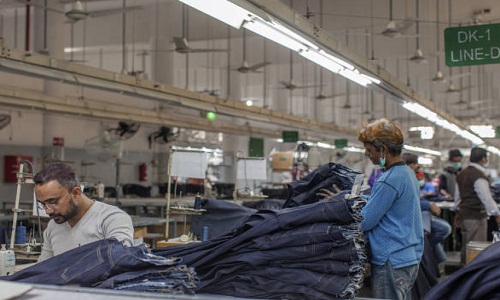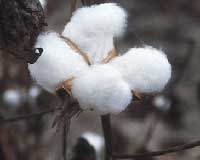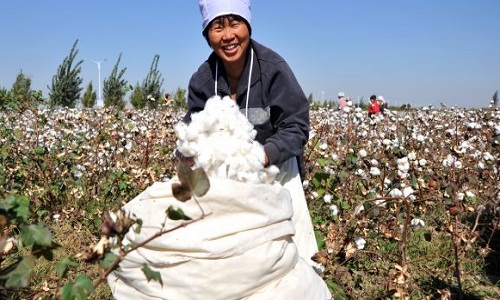FW
"Amidst all odds, Pakistan’s leading denim maker, Artistic Denim Mills, which operates as a one-stop shop turning cotton into jeans, plans to double its production and has already built a new factory in Pakistan’s financial hub. At a time when many textile companies have shut shop, this really comes as a surprise. Being bullish about the prospects, Faisal Ahmed, CEO, Artistic Denim, says he supplies to retailers such as Zara and Next Plc. Unlike most industrialists, Artistic Denim started by making garments about 25 years ago instead of just shipping spun yarn or fabric. Pakistan is among the top five growers globally. "

Amidst all odds, Pakistan’s leading denim maker, Artistic Denim Mills, which operates as a one-stop shop turning cotton into jeans, plans to double its production and has already built a new factory in Pakistan’s financial hub. At a time when many textile companies have shut shop, this really comes as a surprise. Being bullish about the prospects, Faisal Ahmed, CEO, Artistic Denim, says he supplies to retailers such as Zara and Next Plc. Unlike most industrialists, Artistic Denim started by making garments about 25 years ago instead of just shipping spun yarn or fabric. Pakistan is among the top five growers globally. Pakistan has been mostly converting cotton into thread and fabric that is shipped East to other Asian countries, which then manufactured into final garment.

With upcoming elections in July, Pakistan government is under pressure to revive exports and would avoid any measure which would lead them to go to the International Monetary Fund for its 13th bailout since 1988. Accounting for half of overseas shipments, the textile industry remains the key for survival.
Pushing up market share
When new countries are emerging and growing their textile expanse, Pakistan’s performance has been deteriorating year after year, falling behind Bangladesh’s 276 per cent increase and 445 per cent in Vietnam, according to World Bank data. India is the second-largest apparel exporter in South Asia after Bangladesh. However, Pakistan has the advantage of homegrown cotton to capitalise on, unlike Bangladesh and Vietnam.
Pakistan is aiming for its first export jump this financial year after giving tax breaks to exporters, in a bid to reverse a three year slump with value added products like denim getting the biggest incentives, said Mohammad Younus Dagha, Secretary at the Commerce Ministry. Ahmed Lakhani, Analyst at Karachi-based JS Global Capital, points out Bangladesh and Vietnam governments are giving huge support to industries, unlike Pakistan. The tax breaks are a good step, but the government needs to decrease electricity tariffs and keep a check on wages. He is skeptical if government is in a position to do that and that’s where incompetency lies.
Majyd Aziz, President of MHG Group feels about 95 per cent of Pakistani exporters’ mentality is waiting for a customer rather than going out and finding them. In the global world, you need integration and economies of scale, if you do that, you make money. Artistic Denim is one of them. It has chased premium brands in Los Angeles that pay more for smaller deliveries to keep changing designs rather than bulk orders. The company said this will help revenues reach as much as eight billion rupees ($72 million) in year ending June with new garment production capacity increasing sales. According to Ahmed, Pakistan’s denim is on an upward trend, despite the larger textile industry being in trouble.
The Garment Technology Expo (GTE) 2018, held from January 19-22 at NSIC Complex, New Delhi, concluded on an optimistic note for both visitors and technology suppliers who displayed latest innovations. Subcontinent’s largest show for apparel technology had an unparalleled representation from all segments of the sector, with over 350 exhibitors representing over 800 companies and brands from over 22 countries and a big number of 21,736 visitors, made the 26th edition of the GTE a huge success. New country additions this time were Sweden and Switzerland as exhibitors.

Highlights
• Subcontinent’s largest show had over 350 exhibitors representing over 800 companies and brands from over 22 countries
• Sweden and Switzerland exhibited as the new countries in GTE
• A big number of 21,736 buyers visited the show, making the 26th edition of the GTE a huge success.
• Automation was the key theme
• ‘Apparel 4.0’ conference on Day 2, highlighted how Apparel 4.0 is shaping and transforming the global fashion and apparel business.
• GTE next events announced in Bangaluru on August 18-20, 2018, and next grand annual event GTE’ 2019 in New Delhi being held on Feb 22-25, 2019
Showcasing latest technologies and innovations
The key attraction at the fair was technology, the display of machine-to-machine communication systems powered by several tech companies like Juki, Jack, Hikari, Dürkopp Adler and Brother. “As the industry is still on oxygen, the only way to survive is to adopt automation as much as possible so that we can reduce workforce and minimise cost,” observed GS Madan who explored automation in all segments from cutting to stitching and finishing.
Digital printing was showcased by India-based ColorJet, which presented digital printer TXF at the fair. The printer offers speed of up to 24 sqm per hour and can achieve print resolutions of up to 1,440 DPI. The company has ambitious plans in place to expand in apparel manufacturing hubs like Bangladesh and Vietnam. And as Smarth Bansal, Brand Manager, Colorjet points explained, “India is already our stronghold and now we are looking to capitalise on the lucrative opportunities in other emerging countries. We are looking to collaborate with local partners, especially in Vietnam.”

Knowledge sharing at Apparel 4.0 seminar
The 26th Garment Technology Expo (GTE) 2018 presented a new set of opportunities to visitors and exhibitors on Day-2. The major highlight was the ‘Apparel 4.0’ conference. This was the first-ever conference that took place at the garment technology exhibition, held at NSIC Complex, New Delhi. The day-long conference organised by FashionatingWorld, aimed at educating the industry on how Apparel 4.0 is shaping and transforming the global fashion and apparel business. The discussions got a tremendous response and appreciation from industry stakeholders. Global experts and Indian stakeholders spoke about the growing importance of ‘Industry 4.0’ concept and the implementation challenges to Indian apparel industry. The list of speakers included stalwarts Mike Fralix, President & CEO, [TC]2; Dietrich Eickhoff, CEO & Chairman, Dürkopp Adler; Samath Fernando, CIO, Hirdaramani Group of Companies, Sri Lanka, Prabir Jana, NIFT Delhi and Dr Darlie Koshy DG, ATDC among others. The experts highlighted the role and perspectives of both technology providers and users from the point of view of ‘Industry 4.0’.
Also on the agenda was a panel discussion with industry leaders moderated by Rajesh Bheda of RBC and session chaired by Dr Darlie Koshy, DG ATDC. The panel included JD Giri of Shahi Exports, RC Kesar of OGTC; Gunish Jain of Royal Datamatics and Vinod Iyer of Fortuna Colours. Kesar pointed out, “Indian manufacturers appreciate technology but wait for the right time to implement it. If we keep on waiting for the ‘right time’, the time will never come when we are (actually) ready for Industry 4.0.”
Exhibitors satisfied with the response
Umesh Gaur, President (Asia), Tukatech observed, “The fair has been good overall. We are associated with GTE from the very beginning. The response was to the mark. It’s been a win-win situation for us.” Talking about India’s advantage, he said, “India holds the upper hand in many areas if explored well. Indian products are still considered the best in terms of quality, though we don’t produce in quantity like neighbouring countries. We are offering a verity of fabrics and handmade designs.”
Juki India displayed many advance machines this time. R Gopal Kukreti, GM, Juki India, said, “Many machines have been showcased for the first time in India. They are equipped with NTSC technology with direct drives and are connected with cloud. We have launched a machine, which can make 10-12 cuffs and collars in one go. We are mainly into non-apparel and knitwear industry.”
Speaking about changing customer profiles, Macpi India’s Mohanti Basanta Kumar, Director (sales), explains, “We have launched finishers for jackets, considering the demand is very high for casual jackets in the current market trends. The finisher deals with all kind of fabrics. The only condition is that the jackets should be casual. The market is good, not only for our company but the industry as a whole and this trend is here to stay for the next five years. A lot of business is coming in and we hope for the best in future. Personally, this is going to be 20th GTE for me. We have been seeing a change in the manner client deals with us in the fair. Earlier, they would come and strike deals in the exhibition for good amount of discounts, but now clients prefer to come directly to our office and deal with us in the hope that they would be able to make a better bargain over there.”
Overall GTE 2018, generated good business for both exhibitors and customers who came looking to upgrade their technology. GTE is looking forward to further adding successful chapters to their credits in Bangaluru on August 18-20 as well as their next grand annual event GTE’ 2019 in New Delhi being held on Feb 22-25, 2019
South Korea is planning a textile techno park in Uzbekistan. The new facility will be created on the territory of the Tashkent Institute of Textile and Light Industry and the project is being financed through grant funds provided within the official development assistance program of the Korean government. About $15 million will be spent on construction, acquisition and installation of technological equipment, as well as training of personnel.
The main objective of the techno park is the introduction of brand new South Korean innovations and conduction of joint research works in the sphere of material science, dyeing and finishing production, fabric design as well as development of alternative energy sources.
A modern experimental and scientific laboratory will also be located nearby. It will be equipped with the latest samples of the leading weaving, knitting, dyeing and finishing equipment and sewing equipment. The park may be commissioned in September 2018. It is expected to raise the Uzbek light industry to a qualitatively new level of development and improve the training system for the sector, which is considered to be one of the most dynamic and socially important sectors and ranks high among export-oriented industries of the country’s economy. The Uzbek textile industry is mainly focused on cotton, silk and wool.
A Bloomberg report recording changes in US consumer behaviour of income spending on apparel shows early signs of big trouble ahead for the apparel industry. The US apparel industry has been seen a dip since last few years and it seems to be true if one looks at the number of bankruptcy cases filed by apparel retailers. One was doubtful that this was largely due to the E-commerce marketplace where E-companies giants, such as Amazon, roamed the streets like a Titian resulting in brick and mortar stores failing to attract customers.
However, that is not the big picture. Systemic changes are happening in consumer spending behaviour which is narrowing the leverage space. Post ’96, the share of clothing spend for US households was 6.2 per cent, however today, the share has shrunk by 50 per cent to about 3.2 per cent despite the fact that income and spending by Americans has significantly increased during this period.
The report discloses apparel’s share has been chewed into by travel, dining out and other adventure sports which offered more satisfaction to consumers. The expenditure on ‘consumer experience’ – largely travel and food – has zoomed to 18 per cent of spending. Expenses on technology itself accounts for 3.4 per cent of spending — which is more than that of apparel .
The choice and the flexibility to wear any kind of casual clothing during most occasions, including office, has been one of the reasons for the falling expenditure on clothing. To add to chaos, price of apparel has been going south as production cost fell due to the moving of manufacturing in less expensive labour markets and its consequent price competitiveness have become the silver bullet of success.
Chief co-ordinator of Pakistan Readymade Garments Manufacturers and Exporters Association (PRGMEA) Ijaz A Khokhar has requested the government to set up display centres in Dubai and Rotterdam to enhance export. Ijaz said foreign businessmen and professionals globally will be encouraged to conduct business through easier and trouble free visa processing as foreign investors are reluctant to visit Pakistan. He asked the government should give Pakistani visa to businessmen, on arrival, enabling them to stay in Pakistan while they are travelling to South Asia and the Middle East.
Following a negative travel advisory, foreign buyers are reluctant to visit Pakistan for business and marketing because of harassment of Immigration staff at airports amongst other issues. The government should focus attention on establishment of proposed display centre, he assessed and went on to state that there is a felt need for reversion of visa policy to help foreign buyers and investors by making the country trade and business friendly.
He said that to enter into high priced market segment a Product Development Centre and Packing Training Centre should be established with technical assistance from the EU and Turkey to help the business community align with the garment sector. Ijaz feels there is a need for an aggressive marketing plan for garment export to gain the maximum benefits of GSP Plus status. Unfortunately we don't have formulate any marketing plan so far and at this juncture we simply need to implement a marketing plan.
Ijaz said due to non-availability of latest fabric locally the garment sector currently have a limited product line for export as foreign buyers were demanding new garments on G3, G4 and technical fabric raw material which are not available and neither is it produced by Pakistani weavers. Currently over 30 per cent cash flow is blocked as in sales tax refund and custom rebates which is seriously affecting cash liquidity.
The Maharashtra government has decided to permit privatisation of spinning mills and powerloom societies that are operated as a cooperative in the state. The state’s new textile policy permits cooperative spinning mills and powerloom societies to change land use which permits them to start operations in other than industrial purposes. As per the policy, cooperative spinning mills and powerloom societies will be allowed to be privatised, provided they are agreeable to return to the government the equity, loan and interest. The new policy will be in effect from 2018 to 2023.
A government official disclosed, “If there is any change in the industrial use of the land, then an amount will have to be paid to the government as per the prevailing rules under the ‘one time exit policy’.”
Of the 136 societies and mills in Maharashtra, that had asked for funds in the form of a share capital, out of which 66 are running, while others are within the installation stage and a few are into liquidation while three are closed.
To encourage cooperative mills, the state government’s textile department provides funds to cooperative cotton mills 45 per cent of share capital, while 50 per cent are required to be raised in the open market and 5 per cent is borne by the mill board. In the case of mills run by Scheduled Caste (SC) members, the state textile department will provide fund up to 45 per cent of share capital, 50 per cent by the social justice department and 5 per cent will be raised by the mill board.
A textile department official says, “There were no options available before loss making or under liquidation powerloom societies or cooperative mills for their revival. Now, they will have an option by changing the use of land provided following the rules under one-time exit policy.”
ICAHT (International Conference on Apparel and Home Textiles) will be held in New Delhi on September 8, 2018. The theme of the event is 'Creation of ten million jobs in Apparel sector'. It is a cross-disciplinary event and the idea is to explore creativity and the creative process through the lenses of imagination and innovation. It provides an environment for academics, researchers and practitioners to exchange ideas and recent developments in the field of apparel manufacturing. The conference is also expected to foster networking, collaboration and joint effort among conference participants to advance the theory and practice as well as to identify major trends in apparel manufacturing.
Workshops are a special feature of ICAHT. These have been found extremely beneficial to the industry in terms of specific skill upgradation and creation of general awareness and helping the move toward a knowledge economy. Each year India has dipped further behind both competitors and its own previous performance due to no or low capacity building and the lack of a liberal import policy regime for apparel exports. From a peak in 2005, year-on-year market share percentage change has not moved upwards.
But high labor costs in China and low compliance standards in Bangladesh are again providing an opportunity. About 12 million young people in India enter the workforce annually. If the size of India’s garment sector is doubled another 10 million jobs can be created.
Chinese firms are buying well known brands in the hope of upgrading their own image. Buying famous foreign brands is seen as helping them build up their own brands, and proper management and deployment of sales channels may help them gain more popularity with domestic consumers.
Chinese textile giant Shandong Ruyi has announced plans to buy Bally. Shandong is also a joint owner of The Carloway Mill in Scotland, one of the few remaining makers of Harris Tweed. Fosun is said to have already clinched a deal to buy Lanvin, after having nabbed a majority stake in the Italian tailor Caruso in November. It’s doing due diligence on the lingerie label La Perla.
Chinese e-commerce players are also moving quickly into western markets. Secoo, China’s largest luxury e-commerce platform, is looking for opportunities to expand in Europe, while VIP has become an official London Fashion Week sponsor and plans to work with London-based brands throughout the year to help them enter the Chinese market.
But there are concerns about whether a brand like Bally might be devalued after being acquired by a Chinese firm. The management model and the deployment of sales channels will matter if Bally wants to win further recognition in the domestic market in the future.
Sustainable Apparel Coalition (SAC) and the Partnership for Sustainable Textiles will cooperate to create better working conditions and increased environmental protection across global textile supply chains. Both parties will align requirements, tools, and verification systems. In addition, joint member companies can make use of joint activities and shared information in future.
Over the next four years, SAC and the Partnership for Sustainable Textiles will collaborate based on the due diligence approach as defined by the United Nations Guiding Principles on Business and Human Rights and specified by the Organization for Economic Co-operation and Development for the garment sector. Members of the SAC and the Partnership for Sustainable Textiles will develop and test joint verification and reporting systems and explore opportunities for a joint methodology to measure impact.
This strategic collaboration is seen as a step toward a leaner industry with more efficient practices and, ultimately, creating greater impact throughout the supply chains. It will provide companies in Europe with tools and coherent guidance to successfully implement environmental and social sustainability practices along their supply chains. It will create synergies for member companies in implementing supply chain due diligence. Members of both initiatives will benefit from reduced administrative reporting efforts.
"Improving global economy and stronger growth forecast for coming years will have a positive impact on cotton production globally. World cotton demand is increasing with current estimates calling for an increase of approx five per cent in 2017, which is more than double the previous five-year average. China will begin the next round of reserve auctions next month. A successful auction series in 2018 could easily position China to become a larger cotton importer again."

Improving global economy and stronger growth forecast for coming years will have a positive impact on cotton production globally. World cotton demand is increasing with current estimates calling for an increase of approx five per cent in 2017, which is more than double the previous five-year average. China will begin the next round of reserve auctions next month. A successful auction series in 2018 could easily position China to become a larger cotton importer again. Jody Campiche, VP, economics & policy analysis, National Cotton Council (NCC), says world mill use is expected to exceed world production in the 2018 marketing year, and global cotton stocks are projected to decline by 5.4 million bales in the 2018 balance sheet. In NCC’s annual Economic Outlook, she noted global stocks decline is due to reduced inventories in China. China’s stocks are declining with USDA estimating a drop of 8.0 million bales in 2017. In 2018, there is a possibility of an additional 10.0 million bale reduction in total stocks.

According to Campiche, global production is projected at 119.3 million bales in 2018. World mill use is projected to increase around three per cent in 2018 to 124.8 million bales with most of the growth from China, Vietnam and Bangladesh. While projections of global consumption exceeding production normally would be supportive of prices, the implications for the coming year may not be as clear cut as stocks outside China are projected to increase by 8.6 million bales in 2017 and 4.6 million bales in 2018.
Regarding domestic cotton mill use, Campiche said 2017 US mill use is estimated at 3.4 million bales, up 100,000 bales from 2016. The Economic Adjustment Assistance Program continues to be an important source of stability allowing mills to invest in new facilities and equipment. For 2018, the NCC is projecting a modest increase in US mill use of 60,000 bales. She noted that export markets continue to be US raw fiber’s primary outlet. The US will remain the largest cotton exporter with a market share of 39 per cent in 2017 as compared to 40 per cent in 2016. China is currently the top export market for the 2017 crop year, followed by Vietnam and Pakistan. World trade is projected to be higher in the 2017 marketing year, but increased competition from other major exporting countries has led to a decline in the US market share.
Trends Forecast
Looking ahead to 2018, increased competition from other cotton-producing countries is expected to reduce both US exports and US market share. With exports pegged at 14.3 million bales, Campiche projects total US offtake of 17.7 million bales in 2018, leading to an increase in ending stocks of 1.5 million bales. In China, cotton mill use has increased, but competition from lower-priced man-made fibre remains a limiting factor for the continued growth of cotton fibre use. Although internal cotton prices are still strong relative to polyester prices, polyester prices increased in 2017 and are currently at the highest level since 2014. China’s new environmentally-friendly policies could also affect man-made fibre production and use.
Although cotton prices have improved slightly compared to other crops, cottonseed prices have dropped significantly, thus leading to an increase in net ginning costs. Many producers will continue to face difficult economic conditions in 2018. Production costs remain high, and unless producers have good yields, current prices may not be enough to cover all production expenses.












